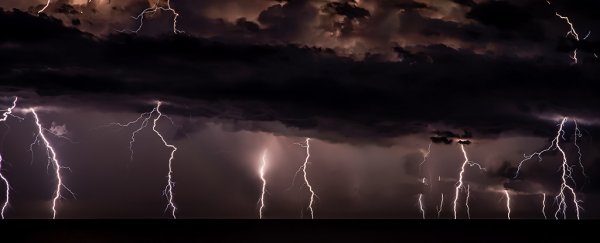Standing on Earth almost 4 billion years ago would have been an incredibly hot, desperately lonely, and very short experience – what with there being no oxygen. Now, new research suggests there would have been less lightning around than there is in modern times as well.
This could make a difference to any of the hypotheses that suggest lightning may have been involved in sparking the earliest life on our planet. If lightning strikes were actually less common on the early Earth than previously thought, that affects those calculations.
To dig deeper, researchers examined how streamer discharges – the sparks that start lightning – might have formed in an atmosphere dense in carbon dioxide and molecular nitrogen, as the atmosphere of the primordial Earth is now thought to have been.
"Basically, in the nitrogen and carbon-rich atmosphere, you need stronger electric fields for a discharge to initiate," says physicist Christoph Köhn from the Technical University of Denmark.
Chain reactions of accelerating and colliding electrons known as electron avalanches are crucial to streamer discharges, and how electrons behave changes depending on atmospheric conditions, which is where this newly found discrepancy comes from.
To complicate matters, we're not exactly certain what the atmosphere of early Earth was like. Here, the scientists used the carbon dioxide and nitrogen hypothesis first put forward in the 1990s by geoscientist James Kasting.
An older proposal from Stanley Miller and Harold Urey, published in the 1950s, suggests that methane and ammonia were actually dominant in the atmosphere during the first billion years of Earth.
It was Miller and Urey who first put forward the idea of lightning forming the building blocks of life on Earth, via experiments in gas-filled flasks, but in recent years the thinking over the atmospheric composition at the time has begun to shift.
"Our simulations show that discharges in the Miller-Urey mixture incept at lower fields than in Kasting's mixture and partly on Modern Earth, which implies that discharges in the atmosphere of Ancient Earth might have been more challenging to incept than previously thought," write the researchers in the new paper.
What all of this means is that the process of producing and building up the prebiotic molecules key to life, via lightning strikes, would have taken longer if recent ideas about the atmosphere of the early Earth are right.
The researchers don't specifically quantify how much longer; they only modeled one of the earliest stages in the process of lightning formation, and there remain a lot of unknowns. However, they do say the variations "could potentially make a big difference" in how frequent lightning strikes were.
There's lots more work to do here, such as expanding the scope of the research to include the entirety of the lightning strike process and add in more models of atmospheric chemistry. Ultimately, we're still searching for answers to the biggest questions.
"If lightning discharges were responsible for the production of prebiotic molecules, it's important to get a very good theoretical understanding of what happened," says Köhn.
"The big question is still, where do all these prebiotic molecules come from?"
The research has been published in Geophysical Research Letters.
